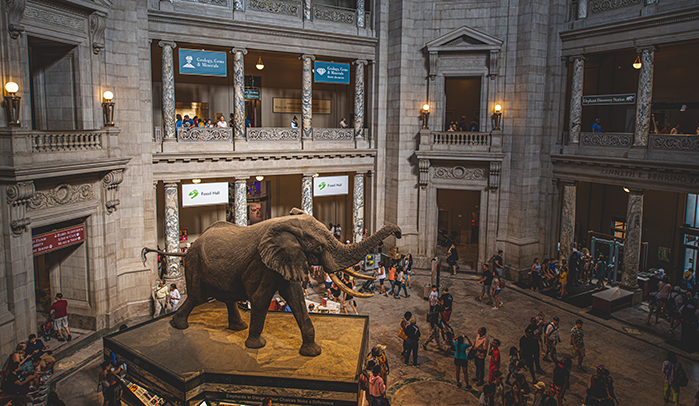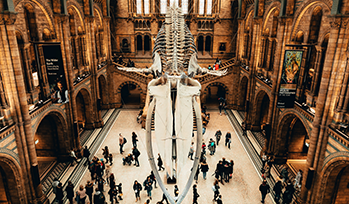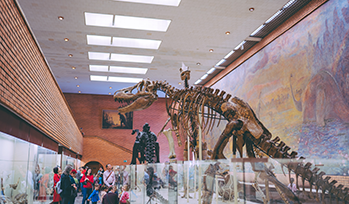Kicking things off in our Homebound Learning Series, we take a virtual travel to the National Museum of Natural History (NMNH) in Washington, DC.

Located on the National Mall in Washington, DC and sitting as part of the Smithsonian Institution’s collection of museums, the NMNH has the largest natural history in the world. From animals, fossils and minerals to plants, human remains and cultural artefacts, this institution stands as the most visited natural history museum in the world. The museum is not only home to exhibitions to explore but laboratories where scientists continue to study natural and cultural history in the world.

What to expect from the National Museum of Natural History tour
A topic that extends beyond the need to understand science, the biology of mammals, and geography, the natural world is relevant to all. Trying to comprehend the history of the planet and how as humans we have interacted with the various environments Earth provides us with not only provides us with a history but opens up dialogue as to how we can sustain our world and make it a better place for all. The NMNH brings together collections of over 145 million scientifically researched specimens and artefacts to create a working guidebook for the curious and new generation of scientists to further shape the models that guide the critical issues of our time, including public health, conservation, climate changes and agriculture.
Did you know? The largest extinction in Earth’s history happened 252 million years ago. It is estimated that 90% of marine species vanished over a period of 60,000 years.
How to explore the National Museum of Natural History
The NMNH consists of three floors. The ground floor consists of research wings (for NMNH staff) and the Atrium Café where school groups would typically be able to take a break and collect their thoughts on the visit to the museum.

The first floor is the place to start with an opportunity to dive into a world of learning. Evolution is the key here with your understanding expanding with each exhibit. Explore the stages of evolution to learn of the journey we have all taken to reach where we are now.
In addition to a staff only research wing, the second floor offers three core themes. Discover the link between nature and culture; examples of excavations; and the world of geology. Explore the world of minerals and gems from Earth and space, the process of mining, and study the composition of rocks. Expect minerals and gems of varying colours, shapes and sizes you’ll unlikely to ever see elsewhere!
A breakdown of areas within the museum
Enter the museum on the first floor at Rotunda South and you will be greeted by the iconic elephant overlooking the information desk. This floor provides learners with access to six permanent exhibition areas (listed below in an anti-clockwise rotation), including:
- Main Circulation Path and Age of Humans Bridge
- FossiLab
- African Voices
- Sant Ocean Hall
- Human Origins
- Mammal Hall
The areas are then broken down into sub areas allowing you to explore additional aspects of life and evolution during the period.
Standing in front of the information desk, you will see the entrance to the Main Circulation Path to your right. This is where you can start your journey and gain an in-depth insight into how life and earth are connected. This includes taking you through Earth’s time periods from Cambrian to Neogene and what happened during these periods of critical environmental change.
The long beginning (Part of the Fossil Bootcamp and FossiLab experience)
|
Life evolves in the ocean (Part of the Fossil Bootcamp and FossiLab experience)
|
Life moves ashore (Part of the Fossil Bootcamp and FossiLab experience)
|
Strange forests of an ice age
|
Familiar food webs emerge
|
From mass extinction to amazing variety
|
Giant dinosaurs roam the world
|
Dinosaurs in a flowering world
|
Mammals take centre stage
|
The age of humans
“From so simple a beginning endless forms most beautiful and most wonderful have been, and are being, evolved.”
Charles Darwin on the origin of species, 1859
Through the NMNH virtual tour you can also explore the movement of people. On the first floor, you can explore the origins of humans in an extraordinary breakdown of our make-up and the numerous actions we do every day but take for granted. This includes physical traits and behaviours which took around six million years to evolve. From walking upright, changing shapes and sizes, creating tools and identifying foods to the development of brains, socialisation through shared resources and networks, plus families, the NMNH provides you with elements few would consider to be crucial to who we are and how we work but are entirely essential to our being.
Sant Ocean Hall and Mammal Hall both provide intricate exhibits that detail life on land and in the sea. Discover why animals thrive in particular areas of the globe, their characteristics and the hierarchy of the animal kingdom. These exhibits are ideal to tie together the learning from earlier in the tour as evolution is broken down further allowing you to compare and contrast anatomy and environments.

The second floor allows you to explore Objects of Wonder; items from cultures and tribes around the world. They provide an opportunity to explore how man have been able to develop identity within social groups and moments in unity. Think about what these items symbolise to the group, individual and in the growth of attachment to inanimate objects which may provide greater meaning beyond your first glance.
Use the arrows and interactive map to head through the butterfly enclosure for a closer look at these varied insects. This is a fantastic addition to the tour and is nestled in amongst the insect zoo and examples of bones that represent moments in evolution in the animal kingdom.
With an additional burst of colour, the geology section on the second floor is a real highlight of the virtual tour. Explore the wondrous diversity of the amazing gems and how they can be grouped. Rare, unique and dazzling, this area of the NMNH will develop your understanding of how gems and minerals are formed. The collection is formed from all over the world and over 300,000 examples which have been collected over the course of a century. Some are so unique they are still being explored by the scientists at the museum. With bright colour combinations and eye-catching natural designs, you’ll be wanting to start your own collection!
The National Museum of Natural History’s place within DC
The NMNH stands out within the Smithsonian Institution. Possibly not least from its association with the family adventure film series Night at the Museum. A film that probes at learning through experiences; learning without realising knowledge is entering the sub-conscious but cementing itself through natural fascination and intrigue. It’s a fitting connection which sums up the fun and education of the NMNH.

Washington, DC is known as America’s attic, with history and landmarks at every turn. There are stories to explore and discover which thread together like a patchwork quilt that not only tells the story of the United States but civilisation. The virtual tour of the NMNH is one way you can explore life and learning and is a worthwhile experience to enhance education and engagement during this period of lockdown and home learning.

Comments are closed here.